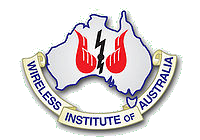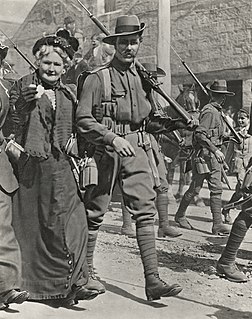
The Wireless Institute of Australia (WIA) was formed in 1910, and is the first and oldest national amateur radio society in the world. It represents the amateur radio operators of Australia as the AR "peak body" in dealings with the Australian Communications and Media Authority (ACMA), the authority under the government of Australia that administers communications within and external to Australia. The WIA publishes a bi-monthly journal for its membership called Amateur Radio. The organisation is the national society representing Australia in the International Amateur Radio Union.

The Australian Naval and Military Expeditionary Force (AN&MEF) was a small volunteer force of approximately 2,000 men, raised in Australia shortly after the outbreak of World War I to seize and destroy German wireless stations in German New Guinea in the south-west Pacific. The German wireless installations were ordered to be destroyed because they were used by Vizeadmiral Maximilian von Spee's East Asia Squadron of the Imperial German Navy, which threatened merchant shipping in the region. Following the capture of German possessions in the region, the AN&MEF provided occupation forces for the duration of the war. New Zealand provided a similar force for the occupation of German Samoa.

Jacqueline Susan McKenzie is an Australian actress of stage and screen.

Ilford is a village in New South Wales, Australia, beside the Crudine River within the Mid-Western Regional Council. It is located on the Castlereagh Highway, about 220 kilometres north-west of Sydney. At the 2016 census Ilford and the surrounding rural district had a population of 187, living in 65 private dwellings. The district also included 43 unoccupied private dwellings. Ilford was named after the English township of Ilford, from where early residents of the locality originated.
George Augustine Taylor was an Australian artist, journalist, and inventor.

Vintage amateur radio is a subset of amateur radio hobby where enthusiasts collect, restore, preserve, build, and operate amateur radio equipment from bygone years, such as those using vacuum tube technology. Popular modes of operation include speaking over amplitude modulation (AM), and communicating using Morse code through continuous wave (CW) radiotelegraphy. Some enthusiasts have interest in owning, restoring and operating vintage military and commercial radio equipment such as those from 1940s to 1960s. Some undertake to construct their own gear, known in ham slang as homebrewing, using vintage parts and designs. A number of amateur radio clubs and organizations sponsor contests, events, and swap meets that cater to this specialized aspect of the hobby.
Kenneth Ivo Brownley Langwell Mackenzie was an Australian poet and novelist. His first and best-known novel, The Young Desire It (1937), was published under the pen name Seaforth Mackenzie.
Call signs in Australia are allocated by the Australian Communications and Media Authority and are unique for each broadcast station. The use of callsigns on-air in both radio and television in Australia is optional, so many stations used other on-air identifications. Australian broadcast stations officially have the prefix VL- and originally all callsigns used that format, but since Australia has no nearby neighbours, this prefix is no longer used except in an international context.
Electronics Australia or EA was Australia's longest-running general electronics magazine. It was based in Chippendale, New South Wales.

The Battle of Bita Paka was fought south of Kabakaul, on the island of New Britain, and was a part of the invasion and subsequent occupation of German New Guinea by the Australian Naval and Military Expeditionary Force (AN&MEF) shortly after the outbreak of the First World War. Similar to New Zealand's operation against German Samoa in August, the main target of the operation was a strategically important wireless station—one of several used by the German East Asiatic Squadron—which the Australians believed to be located in the area. The powerful German naval fleet threatened British interests and its elimination was an early priority of the British and Australian governments during the war.

Robbery Under Arms is a 1920 Australian film directed by Kenneth Brampton and financed by mining magnate Pearson Tewksbury. It is an early example of the "Meat pie Western".

Florence Violet McKenzie OBE, affectionately known as "Mrs Mac", was Australia's first female electrical engineer, founder of the Women's Emergency Signalling Corps (WESC) and lifelong promoter for technical education for women. She campaigned successfully to have some of her female trainees accepted into the all-male Navy, thereby originating the Women's Royal Australian Naval Service (WRANS). Some 12,000 servicemen passed through her signal instruction school in Sydney, acquiring skill in Morse code and visual signalling.
The Manly-Warringah Radio Society (MWRS) is an Amateur Radio enthusiast group serving the Northern Beaches and North Shore areas of Sydney, Australia. Operating under the call sign VK2MB the society boasts members from a wide range of backgrounds, with members ranging from retirees to school children.
Women have been active participants in the development of radio communications since its beginning. The age of radio communication began with the development of wireless telegraphy around 1900, in which Morse code could be transmitted over large distances using simple spark gap or carbon arc transmitting equipment, and various types of detectors for reception. Guglielmo Marconi achieved international fame in 1901 when he succeeded in sending a simple message in Morse code - the letter "s" - across the Atlantic from Cornwall in England to Newfoundland in Canada.

The Australian occupation of German New Guinea was the takeover of the Pacific colony of German New Guinea in September – November 1914 by an expeditionary force from Australia, called the Australian Naval and Military Expeditionary Force.

The Waverley Amateur Radio Society (WARS) is an amateur radio society based in Rose Bay, a suburb of Sydney, New South Wales, Australia which operates under the call sign VK2BV. The society was founded in 1919 and is the oldest continuously licensed amateur radio club in Australia.
The history of broadcasting in Australia has been shaped for over a century by the problem of communication across long distances, coupled with a strong base in a wealthy society with a deep taste for aural communications in a silent landscape. Australia developed its own system, through its own engineers, manufacturers, retailers, newspapers, entertainment services, and news agencies. The government set up the first radio system, and business interests marginalized the hobbyists and amateurs. The Labor Party was especially interested in radio because it allowed them to bypass the newspapers, which were mostly controlled by the opposition. Both parties agreed on the need for a national system, and in 1932 set up the Australian Broadcasting Commission, as a government agency that was largely separate from political interference.

The Women's Emergency Signalling Corps (WESC) was founded by Florence Violet McKenzie in 1939 as a volunteer organisation in Sydney. As World War II loomed, McKenzie saw that with her qualifications and teaching skills she could make a valuable contribution. She foresaw a military demand for people with skills in wireless communications. As she told The Australian Women's Weekly in 1978: "When Neville Chamberlain came back from Munich and said 'Peace in our time' [sic], I began preparing for war."
Edward Hope Kirkby was a jeweler watchmaker in Williamstown, Victoria who eventually became a manufacturing electrician making systems of fire protection. He is best known for his early X-ray experiments and later wireless experiments, among the earliest in Australia. He experimented on his own account and together with George Augustine Taylor. There are no primary references to George Taylor experimenting with wireless telegraphy himself. Kirkby was the technical genius behind Father Shaw and his Australian Wireless Company.












